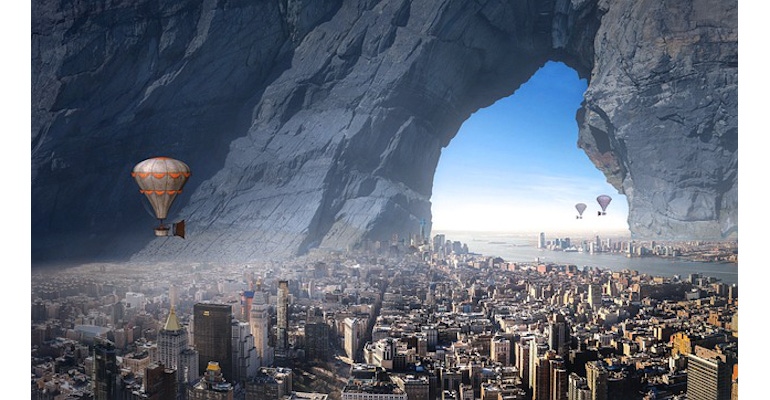Today’s Reality Was Yesterday’s Science Fiction
I’ve seen things even I don’t believe!
February 3, 2023

Every now and then, I start to think about how much things have changed since I was I young sprout, how fast things are changing now, and what we might expect to see in the not-so-distant future.
I was born in 1957 in Sheffield, Yorkshire, England. A few months later, the Soviet Union decided to celebrate this august event by launching Sputnik, which was the world’s first artificial satellite. Although I didn’t know it at the time, WWII had ended just 12 years before I made my appearance. I was also unaware that WWII-era food rationing in the UK didn’t end until 1954, which was only three years before I bid the world a cheery hello.
I graduated from high school in 1975. I remember chatting with my friends about the year 2000, which would mark the end of the millennium, and which was still 25 years in our future, and which seemed such a long time away. Then I blinked. Now, as I pen these words, it’s 2023, which means we are already almost a quarter of the way through the 21st century. Stop the world. I want to get off. I’m too young for all this excitement!
Ever since I was a young lad, I’ve very much enjoyed reading science fiction. It’s scary to think that, almost every day now, I run across something that would have been science fantasy in those days of yore when I wore a younger man’s clothes. Do you recall Roy Batty’s "Tears in Rain" monologue in Blade Runner, which starts “I’ve seen things you people wouldn’t believe.” I know how Roy felt. I’ve seen things even I don’t believe!
I remember reading a post-apocalyptic short story by Brian W. Aldiss called "But Who Can Replace a Man?" The story commences with a group of artificially intelligent machines on a farm discussing the fact that they can’t do their jobs because they haven’t received their daily orders from the city. Just a few months ago as I pen these words, I was introduced to an autonomous tractor that can be left to perform tasks like tilling a field all on its own. More recently, I was introduced to some guys and gals who are producing autonomous agricultural drones. And, just a few weeks ago in a column here on Design News, I talked about humanoid robots that are currently being deployed around the world in places like supermarkets and healthcare facilities. In another column on robot sensory systems, I introduced a skin-like covering that can “provide robots with tactile awareness that exceeds the capabilities of human beings with respect to spatial resolution and sensitivity.”
I remember reading The Terminal Man by Michael Crichton shortly after it was published in 1972. This told the tale of a man prone to seizures and blackouts who was equipped with a rudimentary brain-computer interface. Suffice it to say that things didn’t end up with everyone happy and smiling. By comparison, as we read on Insider, the first implanted brain-computer interface to be turned on in the US seems to be making life much more tolerable for Philip O'Keefe, who is suffering from ALS.
Having seen the mess Elon Musk has made of Twitter, I have to say that I’m less enthused than I used to be about his Neuralink company. I’m still trying to decide what I think about Jeff Bezos and Bill Gates investing in Synchron and its endovascular brain-computer interface. On the bright side, the way things are going, it won’t be long before they can tell me what I’m thinking (hopefully this won’t be followed by them telling me what to think).
The human population recently passed the 8 billion milestone. Watching the real-time estimations of births and deaths on the World Population Clock really gives one pause for thought. That’s a lot of people to feed. A few weeks ago, I saw a report in the CBS Evening News about strawberry picking robots.
In turn, this made me recall an article on Inverse titled "Human-Free Farms Could Solve a Major Food Problem," with a subtitle, “This isn’t your mother’s agriculture.”
All of this then reminded me about a company called Intelligent Growth Solutions (IGS), which is working furiously on growing crops indoors on snooker-sized trays that are illuminated with LED lights from the top and fed with water and nutrients from the bottom. Of course, this caused me to recall numerous generation starship stories, such as Non-Stop by Brian W. Aldiss and Orphans of the Sky, by Robert Heinlein.
I was also reminded of one of my all time favorite science fiction stories, The Caves of Steel (and its sequel, The Naked Sun) by Isaac Asimov. These tales are set about three thousand years in our future. The Earth is heavily overpopulated, so people live underground in vast city complexes covered by huge metal domes (the “Caves of Steel”), each of which is capable of supporting tens of millions of people. Food is in short supply, so although small quantities of items like meat, vegetables, and tobacco are occasionally available (they are farmed by robots on the planet’s surface), they are very expensive, so most of the time people live on rations grown on hydroponic farms or in huge yeast vats.
Hmmm, “Farmed by robots…” “Hydroponic farms…” Does any of this sound familiar? “But what about the ‘huge yeast vats,’” I hear you cry. Dare I be so bold as to mention the Beyond Burger from Beyond Meat and the Impossible Burger from Impossible Foods. And what about the recent article in the Guardian about how precision fermentation could be used to “produce new staple foods and end our reliance on farming” (it would be ironic if we ended up putting all those farming robots out of work).
Several of the science fiction stories I read in my youth involved people living in massive self-contained buildings like mile-high skyscrapers. Examples of this ilk include The World Inside by Robert Silverberg, High-Rise by J.G. Ballard, and Oath of Fealty by Larry Niven and Jerry Pournelle. The reason I mention these here is that I recently saw a column on Futurism.com saying that Saudi Arabia is planning on building a 100-mile-long “Skyscraper City” called The Line that will have a population of 9 million people (there’s no mention of the expected number of cats and dogs). I also ran across this video showing drone footage of The Line under construction.
My understanding is that there will be two long skyscrapers on either side, with a sort of 100-mile long park-greenway type thing running down the middle. I also understand that The Line is supposed to be largely self-sufficient with respect to power and consumables, where the former screams “solar and wind,” while the latter whispers “robot-managed hydroponic farms, vats of yeast, and precision fermentation.” This will either be an engineering triumph or a trillion-dollar disaster, and that’s just the building of it—I don’t even want to think what it would be like to be born and raised in the middle of this type of megacity construction.
We’ve only scratched the surface of the topics I’d like to talk about. I could go on like this for hours, if not days. But enough about me. It’s not all about me (it should be, but it’s not). What about you? What do you think about all of this, and do you have any other topics of this ilk that you would care to share with the rest of us?
About the Author(s)
You May Also Like





